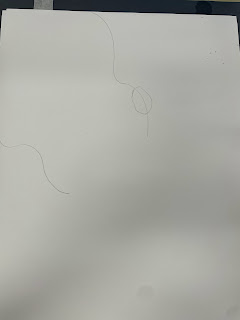For the second project of the year, all of the classes will be making a glow in the dark sea creature! We will be using glow in the dark paint and neon oil pastels to make our sea creatures come to life. At the end of the year art gallery, we will display all of the glow in the dark sea creatures in our very own Glow Gallery!
(Photo courtesy of Cassie Stephens' blog)
Each grade will do a different sea creature. Please scroll down to find the instructions for octopus for the 5th graders.
Supplies:
- Rectangular mixed media paper
- Neon/florescent oil pastels
- Black marker
- Pencil
- Florescent tempura paint cakes
- Water bowls with sponges
- Paintbrushes
- Color wheels
- Spray bottles with neon paint
Please use the document camera in the classroom to show the step by step instructions. One art volunteer can sit at the desk at the front of the room to demonstrate the steps and guide the students through the project. Here are step by step instructions for how to draw and color the octopus. These will also be printed out and available in the classroom for you to lead the students through the project.
Try to save a few minutes at the end of class to turn the lights off in the classroom and turn on the black lights that are in the art closet (or they may already be plugged in around the room). The kids will love getting to see their art projects glow! The oohs and ahhs will be worth it! ;)
1. Name & Teacher name on the back in pencil
2. Will draw the whole octopus in pencil and then trace in marker
3. Start with head of octopus coming out of the left side of the paper
4. Draw the right eye ball, then erase the line in the center of the eyeball
5. Draw the other eye ball
6. Draw the 8 ARMS.
a. FUN FACT: even though most of us call them tenticles, the little apendages that come off the octopus body are actually called arms. That is because arms have suckers all over them, and tenticles only have suckers on the very end)
7. Make one slightly wavy line and then follow that line again starting wider at the body of the octopus and getting thinner and thinner as it comes to a point.
8. Once you have all your arms drawn, time to trace with your black marker
9. Now its time for the oil pastels.
a. FUN FACT #2 Although they look a lot alike, Oil Pastels are not crayons. Oil pastels are very rich, soft and creamy. Hence, they are very easy to smear, blend in, layer, mix, shaded, all with the help of our finger. As opposed to that, crayons are harder and the two crayon colors don't really mix together, very well.
10. Talk about the color wheel and how colors near eachother on the wheel are called Analogous colors and those opposite eachother are called complementary. We will be using analogous colors because they look aesthetically pleasing next to eachother and are easier to blend together to produce a more realistic look
11. Demonstrate how oil pastels can be blended together with your finger
12. **BEWARE** the blue and purple oil pastel doesn’t show up well under the black light. For best results, use those colors very sparingly. You can turn off lights and show what the examples look like and point out where the blue and purple is and how it shows more like a shadow and how the other colors pop.
13. BE SURE to color in the eyes of your octopus with the yellow oil pastel….it will pop the most!
14. When the body and arms are colors in its time to make the suckers.
15. Using a complementary color draw small circles randomly all over the body and arms.
16. We will use tempura paint cakes to paint the ocean background.
a. FUN FACT #3 Tempura paint cakes are awesome. They are a mix of liquid tempura paint and watercolor. They are much less messy and create no waste!!
17. Using tempura paint cakes is a lot like using watercolors. Get your brush wet and rub it on top of the tempura cake. The water will soak in and the paint will become brighter on your brush. These colors also blend together nicely. We want to stick with blue and green for the background so the ocean fades to the back and the octopus pops off the page in the black light.
18. Once your ocean is complete, take your drawing to the spray station. (Make sure to carefully shake the spray bottles of paint as the paint settles on the bottom).
19. Using yellow neon water color in a spray bottle, spray the painting—a little or a lot! It wont show up well in the regular overhead light….but when the black light shows up, it’s will look amazing!:)
20. Make sure to take a few moments at the end to turn off the lights and turn on the black lights!!
21. Have students put their painting in the dry rack when complete.

























No comments:
Post a Comment